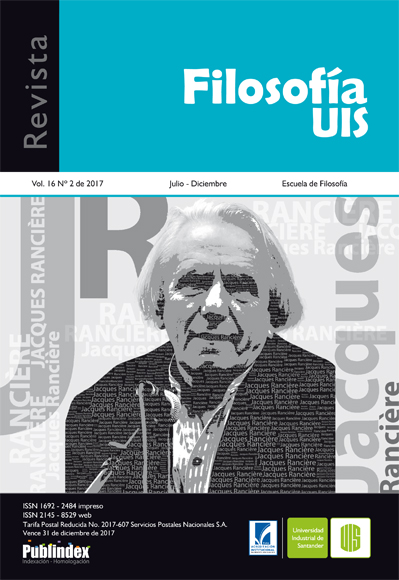The strange political character of Confesión a Laura. An analysis from the concept of Esthetic Regime by Jacques Rancière
Published 2017-12-14
Keywords
- historicity,
- fiction,
- politics,
- sensitivity,
- estrangement
How to Cite
Copyright (c) 2017 Revista Filosofía UIS

This work is licensed under a Creative Commons Attribution 4.0 International License.
Abstract
Confesión a Laura turns the Bogotazo into another time and another space, different from those accustomed to reworking with the greatest of scientistic minds those historians sympathetic to the impracticable objectivity and the panoramic format, which often fog certain key details of memory. And it is in this sense how the film dialogues in its stage and plot development with the concept of aesthetic regime of Rancière, proposing a regime of historicity that conceives of fiction, on the contrary, as the only perceptual procedure to think reality in any of Its possibilities. This dialogue is presented in this article under a methodology of qualitative analysis, comparing the scenic aspects of the film with the conceptualization of aesthetic regime offered by the philosopher Rancière.
Downloads
References
Bejarano, A. (2012). Presencia de lo fantasmático en Confesión a Laura. La Tadeo, (76), 191-202.
Berrío, A. G. & Hernández Fernández, T. (2004). Crítica literaria. Iniciación al estudio de la literatura. Madrid: Cátedra.
Foucault, M. (1974). Genealogía del racismo. Nacimiento de la biopolítica. La Plata: Altamira.
García Márquez, G. (1995). Taller de guion Cómo se cuenta un cuento. Bogotá: Voluntad.
LaRosa, M. & Mejía, G. (2013). Historia concisa de Colombia (1810-2013). Bogotá: Pontificia Universidad Javeriana, Universidad del Rosario.
Moreno, J. (2015). Novela histórica colombiana e historiografía teleológica a finales del siglo XX. Cali: Universidad del Valle.
Osorio, J. (Dirección). (1990). Confesión a Laura [Película]. Colombia: Méliès Producciones cinematográficas Ltda.
Rancière, J. (2012). El malestar en la estética. Buenos Aires: Capital Intelectual.
Rancière, J. (2013). Aisthesis. Escenas del régimen estético del arte. Buenos Aires: Manantial .
Rancière, J. (2014). El reparto de lo sensible. Estética y política. Buenos Aires: Prometeo.
Viñas, D. (2002). Historia de la crítica literaria. Barcelona: Ariel
